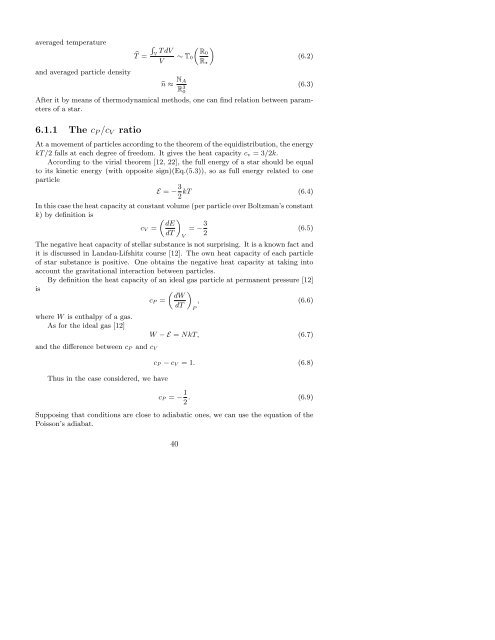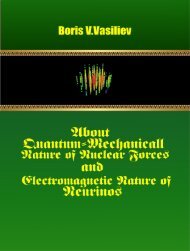VbvAstE-001
Book Boris V. Vasiliev Astrophysics
Book Boris V. Vasiliev
Astrophysics
You also want an ePaper? Increase the reach of your titles
YUMPU automatically turns print PDFs into web optimized ePapers that Google loves.
averaged temperature<br />
and averaged particle density<br />
∫<br />
V ̂T =<br />
T dV<br />
V<br />
∼ T 0<br />
(<br />
R0<br />
R ⋆<br />
)<br />
(6.2)<br />
̂n ≈ NA<br />
(6.3)<br />
R 3 0<br />
After it by means of thermodynamical methods, one can find relation between parameters<br />
of a star.<br />
6.1.1 The c P /c V ratio<br />
At a movement of particles according to the theorem of the equidistribution, the energy<br />
kT/2 falls at each degree of freedom. It gives the heat capacity c v = 3/2k.<br />
According to the virial theorem [12, 22], the full energy of a star should be equal<br />
to its kinetic energy (with opposite sign)(Eq.(5.3)), so as full energy related to one<br />
particle<br />
E = − 3 kT (6.4)<br />
2<br />
In this case the heat capacity at constant volume (per particle over Boltzman’s constant<br />
k) by definition is<br />
( ) dE<br />
c V = = − 3 (6.5)<br />
dT<br />
V<br />
2<br />
The negative heat capacity of stellar substance is not surprising. It is a known fact and<br />
it is discussed in Landau-Lifshitz course [12]. The own heat capacity of each particle<br />
of star substance is positive. One obtains the negative heat capacity at taking into<br />
account the gravitational interaction between particles.<br />
By definition the heat capacity of an ideal gas particle at permanent pressure [12]<br />
is<br />
where W is enthalpy of a gas.<br />
As for the ideal gas [12]<br />
c P =<br />
( dW<br />
dT<br />
)<br />
, (6.6)<br />
P<br />
W − E = NkT, (6.7)<br />
and the difference between c P and c V<br />
c P − c V = 1. (6.8)<br />
Thus in the case considered, we have<br />
c P = − 1 2 . (6.9)<br />
Supposing that conditions are close to adiabatic ones, we can use the equation of the<br />
Poisson’s adiabat.<br />
40













